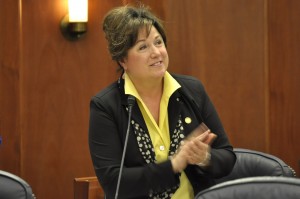It started as a rumor. Democratic lawmakers and some education advocates have heard about it.
That there are new ideas for changing how the state pays for education isn’t a surprise. That this cost-saving proposal could close 60 schools across the state is.
“Certainly there has been talk that 10 students is, quite frankly — with the technology that we have today and the options that are available — it’s just too expensive,” Rep. Lynn Gattis said.

Gattis is a Republican from Wasilla and chairs the House Education Committee. She’s one of the lawmakers considering introducing legislation to change a number of things about how schools in Alaska are funded. One of her ideas is to increase the minimum threshold for schools to receive full funding. She’s considering proposing 25 students as the minimum, but she’s open to a number higher or lower than that.
“If I was in charge, I would open up those options whether it be virtual schools — I went to school when it was correspondence back in the day and we have come a long way,” Gattis said.
Rep. Jonathan Kreiss-Tomkins represents a handful of Southeast Alaska communities. The three schools that were closed in Alaska in the last fiscal year were all in Southeast.
The Sitka Democrat said he unequivocally opposes raising the minimum threshold.
“Closing schools, depriving rural kids of a teacher and a traditional education that kids in cities and parents in cities would reasonably expect is not fair or equitable and it’s a complete nonstarter,” Kreiss-Tomkins said.
Hiking the threshold from 10 students to 25 could mean closure for 60 of Alaska’s schools. Typically once a school goes below the threshold and loses most of its funding, the district is forced to close the school, unless it makes the rare decision to siphon funding from other schools it administers. But in this case, pushing funds around may not even be an option. Many of Alaska’s smallest schools are in the same school districts.
The Southeast Island School District, for example, has nine schools; eight of them have fewer than 25 students.
“Even just talk about the possibility to go to 25 is enough to get parents jumpy. Just the talk will close a few schools because it’s hard keeping enough kids there,” Superintendent Lauren Burch said. “Who’s going to move to a community when they think the school might close?”
Burch said three of the district’s schools lost funding a few years ago because enrollment fell under the threshold. He said the district cut spending on basic school supplies and maintenance for buildings and buses to help keep the schools open.
Republican lawmakers say growth in education spending is unsustainable, and must be checked.
Education Commissioner Mike Hanley says it’s not fair to target education for cuts just because it’s one of the state’s biggest expenses. If cuts to the state budget must be made, he said, then education should be a priority to maintain. As an example, he questioned whether education funding was more important than funding for trail maintenance, or maybe as important as funding for law enforcement.
“At some point we have to say we’re not willing to go any lower in education and I don’t know what that number is,” Hanley said. “But at some point we have to (ask), ‘What’s our constitutional responsibility to provide an education? What’s our moral responsibility to supply and provide an education? And can we still meet that obligation with less money?’”
Comments on a possible change in the minimum threshold were included in several speakers’ remarks during the National Congress of American Indians conference with the Alaska Federation of Natives and during the AFN convention. Concerns were mainly focused on how such a change would make rural education less equitable.
Jennifer Canfield is a reporter at KTOO in Juneau.




